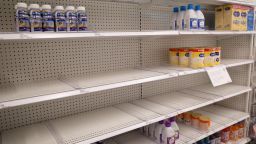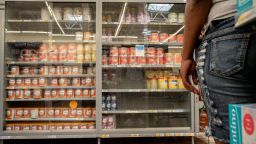Despite improving stock rates, many families with new babies in the United States are still having trouble finding baby formula.
Data from market research firm IRI shows that the share of powdered baby formula products that are out of stock in the US has nearly been cut in half over the past few months. About 18% of powdered formula was out of stock in the first week of October, compared with more than 31% in mid-July, at the height of the shortage.
But stock rates are still worse than they were before the formula shortage hit. Just 10% of products were typically out of stock prior to this winter’s nationwide recall of baby formula and the subsequent shutdown of a major manufacturing plant – and families are still struggling.
Nearly a third of households with a baby younger than 1 said they had trouble finding formula over the course of one week last month, according to a survey conducted by the US Census Bureau. More than 40% said that they had only a week’s supply or less on hand.
Carrie Gillispie’s second child was born in March, just weeks after the nationwide recall.
While the acute fear of not having anything to feed her child is behind her, it’s still a very present concern that she thinks about and plans for daily.
“The fear of it has stayed with me,” said Gillispie, who lives in Maryland. “And it’s much better now, but now it’s just turned into anger that it’s still happening and that I still have to search high and low. My baby’s 7 months old now.”
Throughout the formula shortage, quantifying the severity of the situation has been challenging. At times, stockpiling has skewed sales data to seem like more formula is getting to more families, and manufacturers have limited the options they made available – consolidating to offer one can size instead of two, for example – both of which could affect stock rates.
The Census survey data adds an important measure of personal experience to the mix, but it has limitations, too. The Household Pulse Survey is an “experimental” product with a limited sample size and less rigorous testing than other Census products. The latest release is the first time questions about formula were included, so there is no way to compare to other points in the shortage or to baseline experiences before the shortage.
Even with a noticeable improvement, Gillispie says, the formula situation now feels different than when her first child was born three years ago. She has adjusted her routines and leans heavily on her support system – including her mom and pediatrician – to help ensure that her limited supply doesn’t reach zero.
“Even now, I have to plan in a run to one or two grocery stores every day to just see what’s there and grab something if it’s there,” she said. “But a lot of times, there’s actually nothing there. There’s probably one kind, maybe two kinds, but usually there’s just one bottle left or one can left.”
The stress of being a parent is different, too.
“With my first child, the things that were scary to me were really typical things that I knew I could take care of. It was just a matter of learning how to be a mom,” she said. “But this time around, what’s scary is something that’s really out of my control, and really out of the control of everyone I know.”
Experts say the shortage is not over, but it’s better than it was – and some lingering effects run deeper into a flawed system.
“The shortages now tend to be spot shortages,” mostly affecting those who need certain specialty formulas and those who struggle to substitute the specific formula their child is used to, said Dr. Steve Abrams, a neonatologist at the Dell Medical School at the University of Texas at Austin.
“Trying to buy infant formula was always a chaotic mess. And now, when there aren’t so many options and gas is expensive, it’s become worse.”
The Census survey asked only about “difficulty obtaining infant formula,” leaving the definition of that statement open to interpretation. Responses could be related directly to the ongoing shortage or to broader experiences of food insecurity or transportation challenges.
Low-income families and those living in rural areas are of particular concern to Abrams and others.
“The spot shortages are much worse for non-urban families. So if you’re in a big city and you go to one place and you don’t find what you want, the next place is two blocks over. But in a small town, the next place is 20 miles over,” Abrams said.
“I think when people talk about having trouble, I think they’re talking about having to go to multiple stores, which may mean driving 50 to 100 miles. People don’t have the money to waste on that, or trying three different formulas to see which one their baby likes.”
Low-income households have been disproportionately affected throughout the formula shortage, and they continue to be among those impacted, the Census survey shows.
Households with an annual income of less than $75,000 were twice as likely as those with an income of $100,000 or more to report trouble getting baby formula last month and to say that they have a week or less of formula on hand.
“I still worry about it because I think it really unfairly and unjustly impacts parents who have to struggle to source an essential ingredient for their kids’ nutrition,” said Dr. Jack Maypole, a pediatrician at Boston Medical Center and clinical associate professor at Boston University who has helped coordinate local efforts to address the formula shortage.
“It’s not as bad as it was,” he said. People aren’t walking in quite as often with empty cans to show him that they have nothing to feed their children.
“But we are still encountering parents who can’t afford to take the time off of work to go chase down formula, but they have to because they have to feed their baby.”
Through Operation Fly Formula, the Biden administration has imported nearly 1 billion 8-ounce bottle equivalents of formula from abroad to help ease the shortage. The Special Supplemental Nutrition Program for Women Infants and Children, or WIC, also expanded flexibilities for low-income families. About half of all baby formula sold in the United States is purchased with WIC benefits.
But navigating complicated formula labels and understanding which options are appropriate substitutes is no easy feat, experts say. And it’s especially challenging for low-income families who often have less resources to research and plan.
“The store shelf itself isn’t very friendly for families,” Abrams said.
Gillispie says she regularly texts her pediatrician pictures of the few formula options that she does find in stock to confirm they’ll work for her baby.
Get CNN Health's weekly newsletter
- Sign up here to get The Results Are In with Dr. Sanjay Gupta every Friday from the CNN Health team.
In this way and others, she’s more fortunate than many, she says.
“I just can’t imagine how much worse it is for a lot of parents out there who don’t have the resources and the privilege I have – the pediatrician I can text, and the car and the gas money to drive to five grocery stores, and the time to do that, and the mom nearby with time to do that, too.”
Throughout it all, though, the resiliency of parents and caregivers has been apparent.
“Regardless of someone’s background or community, one of the things that we admire in pediatrics is the simple heroism of the every day,” Maypole said. “I think this is a reflection on all of us in terms of what we’re willing to do, what resources we’re willing to put forth, and how committed we are to solving the problem – not just for expediency or political game but for the greater good and for the future of our kids.”







